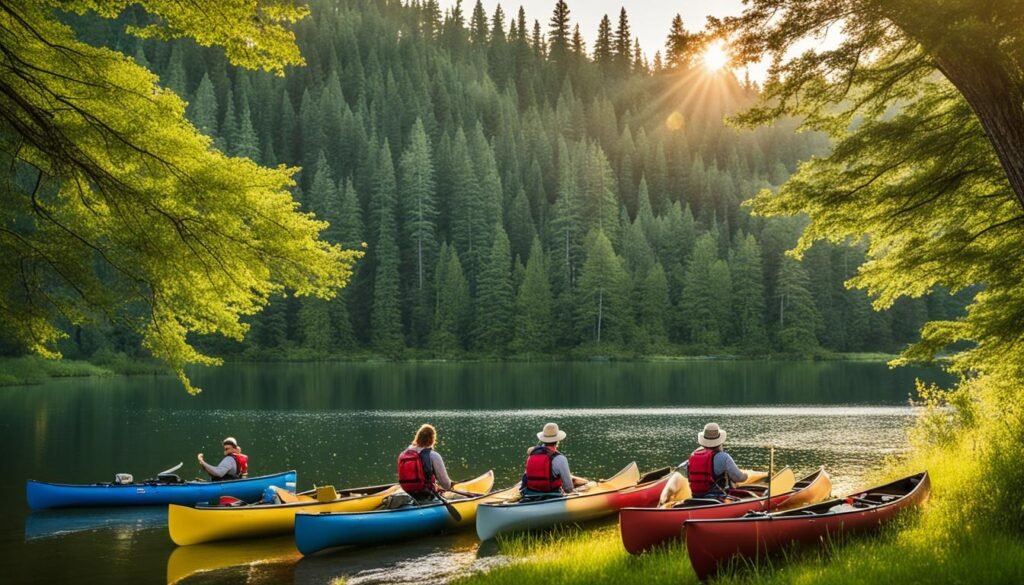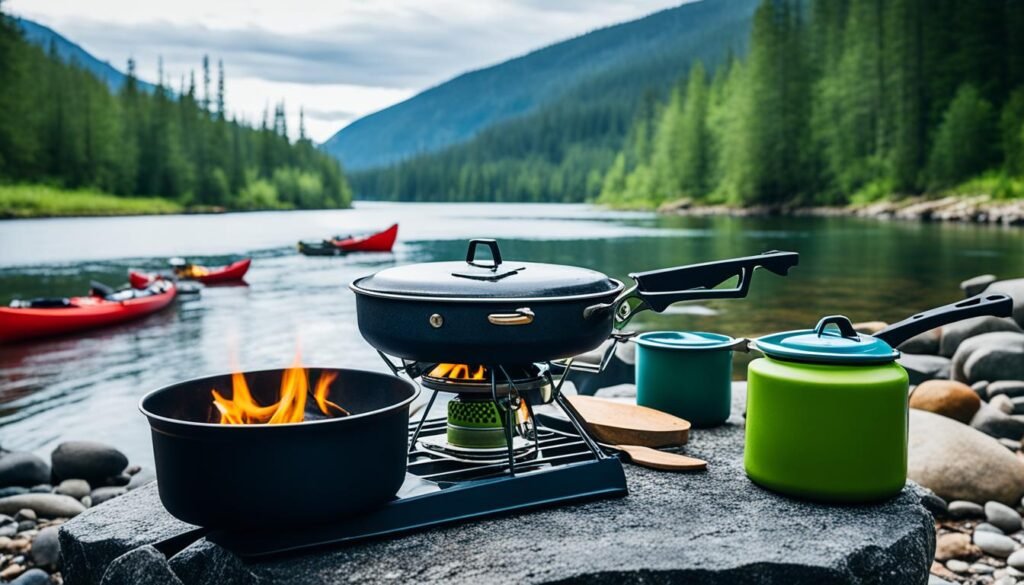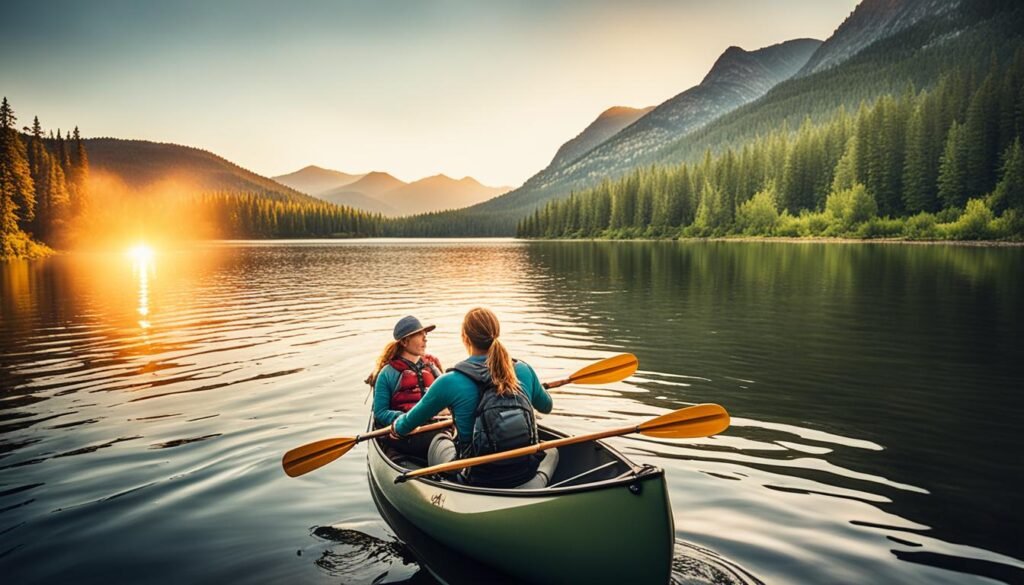Canoe tripping is a big part of North American history. It blends the fun of backpacking with the chance to bring more gear. Last year, over 58 million families went camping to enjoy nature and take a break from city life.
Starting with canoe camping means following several important steps. These steps help make sure you stay safe and have fun. You’ll need to decide what kind of trip you want. It could be a chill day on a calm lake or an adventure on a 740-mile path like the Northern Forest Canoe Trail.
Learning all you can before your trip is key. This could mean choosing the right spot or knowing what to bring. For example, New York’s Adirondack Park and its vast Saint Regis Canoe Area offer lots of options for all adventurers.
Planning your canoe trip lets you dive deep into nature’s beauty. You can decide if you want to go on a simple trip, a loop, or start and end at different points. This flexibility makes planning exciting.
Having the correct gear, like waterproof maps, is really helpful. This is even more true for longer trips with many rivers and streams. Canoe camping combines getting ready for the journey with the excitement of exploring the wilderness.
Introduction to Canoe Camping
Canoe camping combines history and the practical use of canoes. They are key for discovering new places. This type of camping is about traveling and bonding with nature. Canoers usually plan to travel ten to twenty miles daily, over calm lakes and rivers.

Paddling into the wild offers freedom to see untouched places. Canoes carry a lot of gear, making a good buoyancy aid vital. It keeps you safe on varied waterways. A comfortable sleep is important after paddling all day. So, an air mat and proper sleeping bag are key.
Canoe camping blends adventure with careful planning. Remember to bring a head torch and matches for night campfires. Use a firebox to protect the ground. Drinking river water is not safe, so bring enough fresh water. It’s also smart to pack food that won’t spoil.
Keeping the canoe balanced, or “trim,” improves safety and how well it paddles. You need to adjust the canoe’s balance depending on the wind. Before the trip, check the canoe’s stability. The suggested gear weight is around 50lbs per person. Often, you might need to carry your canoe past obstacles twice.
Canoe camping taps into our urge to explore and unite with nature. This mix of outdoor cooking and smart meal prep is part of its charm. Such experiences leave lasting effects on us. They draw people to wilderness paddling and adventure.
Choosing Your Destination
For canoe trip planning, picking the right spot is key, especially for newbies. Last year, camping attracted 58 million North American families. It shows how popular this outdoor fun is.
The Boundary Waters Canoe Area Wilderness in Minnesota is a top place for first-timers. It offers calm flatwater trips. This makes it perfect for those new to canoe camping. The Boundary Waters has lots of water routes. It mixes peaceful paddling with beautiful sights.
The Northern Forest Canoe Trail is another great pick. It’s a long 740-mile path with 23 rivers and many ponds and lakes. I usually pick parts of the trail that match the group’s skills. For beginners, sections with calm waters are the best. They help build confidence.
The Saint Regis Canoe Area in New York’s Adirondack Park is stunning too. It has 18,400 acres with 50 ponds and lakes. It’s great for quiet water trips. Beginners find it welcoming.

In canoe trip planning, getting expert advice is a step I always take. Talking to seasoned paddlers or local shops is smart. They help ensure the trip matches everyone’s skills.
Choosing the right first canoe trip is about mixing fun and practicality. The Boundary Waters, Northern Forest Canoe Trail, or Saint Regis Canoe Area each offer special trips. They are great for flatwater trips in wilderness areas. Picking the right spot is the start of an amazing adventure.
The Right Group for Your Trip
The success of a canoe camping trip often lies in picking the right crew. Keeping group dynamics in mind is key, especially during long trips. It’s crucial to choose members who are both skilled and can work together well. Having both seasoned paddlers and eager newcomers brings a good mix. This balance gives guidance and new ideas.
Starting off with a clear selection process is important. It means looking at each person’s skills and health. There should be a leader to handle planning, safety rules, and make quick decisions. A good leader keeps the group together when things get tough. This helps everyone stay aligned.
All members should know the safety rules well. This covers wearing life jackets, taking swim tests, and learning how to rescue others. More skilled paddlers can help teach the less experienced ones. This raises both safety and fun levels. Plus, it’s comforting to have a leader watching over the group’s well-being.
Planning the trip in detail is also key. Make a comprehensive float plan with routes and emergency numbers. Letting people know about your plans adds an extra safety net.
To top it off, enjoying the journey while respecting everyone’s boundaries matters a lot. A great canoe trip is about more than just the outdoors. It’s about the bonds formed and memories made together.
Researching Your Trip
Successful canoe camping trip planning starts with good research. I look at many reliable sources to get ready. One of the first places I check is guidebooks. They have detailed maps and information about different places you can go. These books are super helpful for beginners. They recommend routes that are good for any skill level.
Talking to park rangers is also key. Ranger information gives me special insights. These are insights you can’t find online or in books. Rangers tell me about the latest conditions and wildlife. They also update me on any changes in the area.
Then, I look at online forums. These forums have discussions from people who love canoeing. They share their experiences, tips, and tricks. But, it’s important to make sure the information is reliable.
I also get the latest maps and confirm details with outfitters and guides. For newbies, using professional services is very helpful. I check outfitters for their safety, guide training, and equipment quality. I also look at what other customers have said about them. This helps ensure a fun and safe trip.
In conclusion, mixing info from guidebooks, rangers, and online forums is key. This mix helps me plan very carefully. It makes sure my trip is safe, well-prepared, and lots of fun.
Essential Gear for Canoe Camping
Starting a canoe camping journey needs careful planning. You’ll need a checklist for a safe and fun time. Your canoe pack should be between 90-120 liters, giving enough room for your stuff. For keeping food safe, use barrel packs of 30 or 60 liters. This works well with bear canisters or hangs, depending on local rules.
For paddling, make sure your canoe has must-haves like paddles, life jackets, and a bail kit. Choose a canoe that’s light, no more than 50 pounds, to make carrying it easier. A paddling life jacket is great for spending a lot of time in water because it lets you move freely.
Wearing the right clothes is vital for comfort. Bring merino wool layers, pants that turn into shorts, and a waterproof jacket. You should have old sneakers for the canoe. Plus, waterproof shoes for camp and flip flops for hot weather are needed.
There are many shelter choices, like a light tent under 10 lbs, tarps, or hammocks. It depends on what you like and the weather. Use a 10’x10′ tarp for extra cover. A cozy sleeping bag and pad will help you sleep well.
Don’t forget safety gear. You need a buoyancy aid, first aid kit, and maybe bear spray or a snake kit. The first aid kit should have bandages, gloves, tape, scissors, and your meds.
Lastly, pack your gear in a few bags to make carrying everything easier. With the right gear and checklist, you’re all set for an amazing canoe camping trip.
Finding Resources and Guides
When planning a canoe camping trip, the right resource can make all the difference. For both newbies and experienced paddlers, canoe trip outfitters are a big help. They offer equipment rental and personalized guide services.
This makes your outdoor adventure safe and fun. These experts make sure you have top-notch gear and know the area well.
When picking an outfitter, look at their safety record, gear quality, and experience. Brands like Old Town provide strong, flexible canoes. This means the right boat makes your trip much better.
If you can’t keep a boat or don’t want to buy one yet, renting is a great option. Outfitters have what you need.
Don’t forget about local specialty stores, though. Their staff knows the local waterways and campsites very well. These stores give personalized tips without extra cost.
Their advice on what to eat, what gear to bring, and rules to follow is super helpful. It makes your trip smoother and more fun.
Planning Your Route
When you plan your canoe trip, knowing about route logistics is key. You must decide the type of trip—out-and-back, loop, or point-to-point. The Northern Forest canoe trail is great for all. It’s a 740-mile trail connecting 23 rivers and streams, 59 lakes and ponds, and includes 65 portages.
Mapping your paddle is important to avoid dangerous waters. The U.S. Coast Guard says you must have life jackets. Texas Parks & Wildlife warn about flash floods. You need a good, waterproof map for safety. Many like the Garmin inReach Mini for its dependability on the water.
Planning may also mean arranging pick-ups and drop-offs with outfitters. This makes your trip easier. For example, the large Saint Regis Canoe Area in New York offers many lakes and ponds. Getting car shuttles or talking with guides helps. This way, your trip suits everyone’s skills.
Safety Considerations for Canoe Camping
Canoe camping is an amazing way to enjoy nature. Still, it’s vital to focus on canoe camping safety. Whether you’re on the Northern Forest Canoe Trail or in New York’s Adirondack Park, safety can make or break your trip.
In 2022, over 58 million North American families went camping. This shows how popular such adventures have become. A key safety tip is always wearing a Personal Floatation Device (PFD). Choosing a PFD, like the Astral Ringo, can offer both mobility and crucial safety features.
Knowing weather patterns is crucial for canoe camping safety. It affects gear choices and water conditions. A sudden weather shift can change everything. So, always check the weather forecasts and local advisories.
Also, it’s smart to leave a float plan with someone reliable. This plan includes your route, return time, and emergency info. For long trips, like the 740-mile Northern Forest Canoe Trail, a detailed float plan is essential. It helps people know where you are.
Knowing about the area you’ll camp in is important too. This includes local temperatures, terrain, and wildlife. For example, when I paddled New Zealand’s Clarence River, knowing the local conditions was key. This shows how crucial planning and respecting nature are.
By focusing on these safety tips—using PFDs, understanding weather patterns, and making float plans—you’ll not only be safer. You’ll also enjoy your canoe camping trip more.
Preparing Your Canoe
Before any canoe camping trip, proper canoe care and load balance are key. I start by inspecting the canoe closely. I look for wear and tear, especially at seams and joints. This check is for safety on the journey ahead. For those without a canoe, renting is easy. Companies like Old Town in Maine have great options.
Keeping the canoe stable on the water means balancing the load well. When I pack, I spread the weight evenly, keeping the canoe’s limit in mind. My canoe can hold up to 450 lbs. So, with two paddlers and our gear, we stay under this limit. I pack only what’s needed and use ziplock bags for food.
Knowing how to paddle well is crucial too. On calm rivers or tough rapids, good strokes matter. Strokes like the forward, J-stroke, and draw are key. To get better, try lessons or workshops.
Many canoe rental places offer shuttle services. This service was a big help during my Saint Regis Canoe Area trip in New York. These services make adventures more doable. In 2022, over 58 million North American homes went camping. Such services make exploring easier.
To summarize, a great canoe camping trip starts with detailed canoe care, smart packing, and good paddling. Using trusted rental services when needed helps too. This way, you’re ready for the fun and challenges of canoe camping.
Meal Planning and Food Preparation
Planning meals for canoe camping mixes adventure and good eating. Canoes can carry more, so food can be fancier. We need enough food to keep energy up, as paddling uses 200-700 calories per hour. For light paddling, you need 30-60 grams of carbs each hour. For harder paddling, it’s 60-90 grams.
Drinking enough water is key, needing 0.5-2 liters each hour. Losing salt through sweat means watching your sodium intake, needing 100-4000 mg per hour. Packing the right food means thinking about what keeps well. Choose snacks and meals that fit canoe life and keep you hydrated.
Use light, dried foods to make carrying easier. Everyone should bring utensils, a knife, a stove, and cooking basics. Being smart about packing lets you bring fresh or durable food. This makes eating well possible.
For meals, think granola or eggs for breakfast. Lunch could be wraps with dried hummus. Dinner might move from fresh to dried food. Snacks like trail mix or fruit bars are good. Don’t forget hot drinks to stay warm. Consider the group’s size, who’s cooking, and any allergies. This ensures everyone enjoys the food.
How to Plan Your First Canoe Camping Trip
Getting ready for a canoe camping trip is as important as the journey. A good trip planning checklist covers every part. Picking a spot easy for beginners is fun. I might choose the Boundary Waters or Saint Regis Canoe Area in New York.
I look at guidebooks, talk to rangers, and browse online to gather info. This ensures I have the right permits and gear. Learning to paddle well is part of my paddling preparation.
If I don’t have a canoe, renting one is easy. Places like Maine or Ontario have great ones. Packing a top-notch Personal Flotation Device (PFD), like the Astral Ringo, is key.
The last step is making sure my canoe is balanced. This helps avoid tipping. It also means I can plan tastier meals, since I don’t have to carry all my gear on my back.
A thorough trip planning checklist keeps track of everything. It ensures my permits, gear, and routes are ready. This way, I can enjoy the beauty and excitement of canoe camping.
Experiencing the Adventure
Stepping into your canoe marks the start of an incredible journey. It offers a deep connection with nature. The Northern Forest Canoe Trail is a beautiful backdrop for this adventure. It stretches 740 miles and includes 23 rivers and 59 ponds and lakes.
In New York’s Adirondack Park, the serenity of the Saint Regis Canoe Area strikes me. It covers 18,400 acres with 50 ponds and lakes. Owning a durable Old Town canoe brings simplicity and freedom. Adventures range from easy flat waters to the challenging Clarence River in New Zealand.
Stability and essential gear like a Personal Floatation Device (PFD) are key. The Astral Ringo, at $170, offers safety and comfort. Beginners should start with trips of 1-3 nights. I paddle at 3.5 kilometers per hour and limit it to 4-5 hours/day. This pace allows enjoyment without exhaustion.
Boat-in-only campsites in parks are convenient with facilities. High-protein snacks and an EcoFlow Portable Power Station keep me going. Safety gear, like life jackets and satellite phones, ensures security. This blend of tranquility and challenge creates unforgettable memories. It also grows a deep appreciation for nature.







